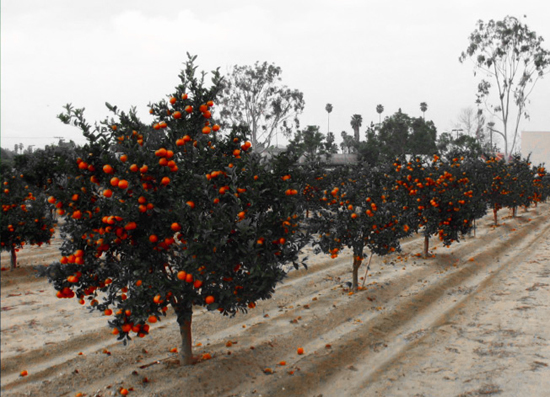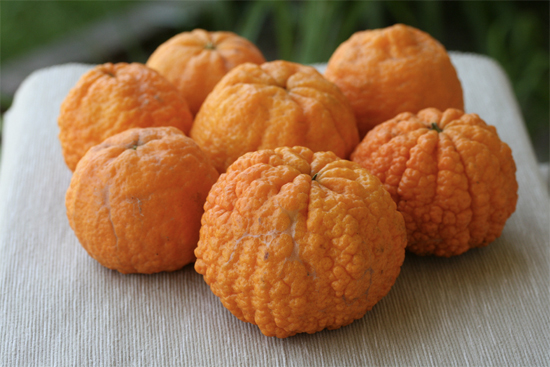Design Specs for a Genetically Ideal Snack
How plant geneticists are growing convenience food on trees
/https://tf-cmsv2-smithsonianmag-media.s3.amazonaws.com/filer/20120229053019fruits_470.jpg)
This is the second installment in the series about how the seedless mandarin has been designed to dominate the citrus market. Read the introduction here
When a new variety of fruit graduates from the breeding orchard to the consumer world, it needs a name. But not just any name will do. Agricultural scientists have found that the public prefers two-syllable words—something familiar, positive, and indicative of the fruit’s best traits. When the tiny mandarin Citrus Reticulata Blanco VI 765 was ready for its public debut, its creators dubbed it “Tango.”
Tango is the result of more than two decades of research at the University of California Riverside. As with any design process, the goal of developing the Tango was to solve a problem: “Its predecessor had too many seeds,” says Mikeal Roose, the plant geneticist who, along with fruit breeder Tim Williams, is responsible for inventing the Tango. “It was very difficult for growers to grow in many situations. So we initiated back in the 1990s a research program to develop seedless forms of some of these varieties, because that’s really what the market demanded.”
Roose has spent most of his career crafting citrus that sells. The inherent characteristics of the mandarin—small size, sweet taste, easily removable peel—make it a great candidate for refinement. Adding seedlessness to the list of traits makes all the difference in the marketplace. A 2005 UC Riverside study estimated that mandarins without seeds garnered three to four times more revenue than seeded varieties.
The Tango was Roose and Williams’s answer to this promising stat. Seedlessness turns the raw fruit into a convenience food the likes of which are usually only found in shelf-stable (and blood sugar destabilizing) processed products like Fruit Roll-Ups or NutriGrain bars. Working from the genetic template of the W. Murcott Afourer mandarin—a variety grown widely in California but plagued with excessive seed content, the scientists undertook an experiment. “For a fruit variety, we don’t actually need seeds to propagate,” Roose explains, “We take sticks—pencil-size pieces of tissue from the plant—that have dormant buds on them, and we expose them to radiation like a dental X-ray.”
The irradiation process induces random mutations—a phenomenon, Roose points out, which also occurs in nature as a result of ambient or solar radiation. “Farmers have long selected citrus varieties that are low-seed, that have the same kinds of chromosomal rearrangements stimulated by the same thing—there’s natural radiation around all the time and it can affect the trees at any time.” Of course, the natural radiation present in our environment exposes us to around 310 millirem per year, while the budwood in a UC Riverside citrus breeding program receives 30-50 Gy of exposure, or 3,000,000-5,000,000 millirem—at least 10,000 times more than what’s found in average surroundings.
The advantage of inducing mutations, Roose explains, rather than waiting for the sun to trigger genetic variation, is that it can be targeted toward manipulating one particular feature—a kind of rapid prototyping for agriculture. The radiation accelerates the output of new genetic compositions. Each is then cultivated, screened and tested with the hope that at least one will be reliably superior to its antecedent. “We’re greatly building upon the work of the breeders that have gone before us,” says Roose, “We look for the characteristics we want, then in some cases we can improve upon it.”
The Tango’s triumph is not only the fact that the fruit is seedless, but that the tree on which it grows will not begin producing seeded fruit in the presence of bees. While bees are imperative to farming products like almonds, apples and stone fruit, contributing billions of dollars in economic value through pollination services, they have the reverse impact on seedless citrus—they can quash the saleability of whole orchards. Cross-pollination has been a problem for California mandarins in particular, and small farms especially, where the density of acreage makes it difficult to grow the fruit in isolation from hives and other crops.

Tango mandarins growing on the research orchard at UC Riverside
The battle between beekeepers, bee-dependent farmers and growers of seedless fruit has been such an issue, in fact, that in 2007 the California Secretary of Agriculture authorized the formation of the Seedless Mandarin and Honey Bee Coexistence Working Group, which was tasked with developing mutually agreeable best practices that would keep all parties in business and relatively happy. But they couldn’t agree. (More on trespassing bees and land use in a future post.)
The Tango’s lack of viable pollen presented a potential workaround for mandarin growers, eliminating the need for isolation or protective (and expensive) netting during bloom. Of course, sterility could also eliminate the longstanding reciprocity between bees and flowering trees, which is not good for honey producers. Without pollen, bees lack their primary nutrient supply. And unlike the whimsically named mandarins, “Orange Blossom Honey” is a product named for its source.
But while new seedless mandarin varieties may put bees out of a job, they could create more work for people. Beyond the pursuit of seed reduction, scientists are also working to develop fruit that will mature during natural gaps in seasonality. Such a product would both smooth out the year-round consistency of store-bought mandarins, and provide steadier work for seasonal laborers. “To keep people employed, it’s desireable to have fruit that mature year-round,” says Roose. “There’s a sort of social benefit.”
Currently, citrus companies pack different types of mandarins in their branded packages at different times of year. Satsumas come first—around September in California; Clementines pop up toward Christmas. The latest to mature include a variety developed at the University of California called Pixie. During the citrus off-season, fruit for those cheerful boxes either comes out of storage or from the southern hemisphere.
The variety Roose designed to bridge this gap is named Daisy SL. “I think Daisy can fill a marketing niche,” Roose projects, “There’s a window, an opportunity for a variety that mature between clementines and the Tango, in the middle of the season.” Placing the Daisy in that window requires not only well-timed ripening, but also a checklist of aesthetic characteristics that help it blend in with its early- and late-season cousins. “When we design a fruit, we’d like it to have a smooth rind and for the rind to be a deep reddish-orange. That would be a color that would sell well, that’s what we’d think from a design perspective.”
They don’t always get it right. The Gold Nugget, which Roose and Williams released about six years ago, hit the mark on seasonality, ripening on the tree as late as June. And the flavor is great—“Many people think it’s the best tasting mandarin that has been produced.” But it’s an ugly duckling. “Gold Nuggets has a rind that’s kind of rough,” Roose says, “And I’d call it a yellowish-orange color, not the deep reddish orange that we’d have specified. It doesn’t meet the design criteria.”
Just as with any product, though, at a certain point you have to release your new design into the market and see what happens. The Gold Nugget didn’t please Americans, but it’s taking off in Europe, where shoppers don’t seem to mind the irregular rind and light color. “Consumers have learned that if it looks that way, it’s going to taste good,” observes Roose, acknowledging that preferences are individual and unpredictable. “There’s not one kind of car that’s suitable for everybody and there’s not one kind of citrus that’s suitable for everybody,” he adds, “Things don’t always work the way you’d expect.”
The varieties that enjoy the greatest commercial success are often unknown to the average mandarin lover. If you bought a box of Cuties or Delites in the last few weeks, you may in fact have purchased some of the first Tangos to hit the supermarket. If they looked just as jewel-like and tasted just as sweet as your last box, the scientists at UC Riverside have designed a winner.
/https://tf-cmsv2-smithsonianmag-media.s3.amazonaws.com/accounts/headshot/sarah-rich-240.jpg)

/https://tf-cmsv2-smithsonianmag-media.s3.amazonaws.com/accounts/headshot/sarah-rich-240.jpg)